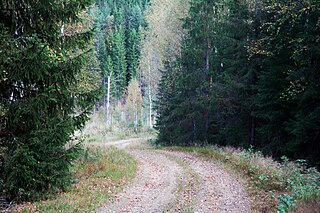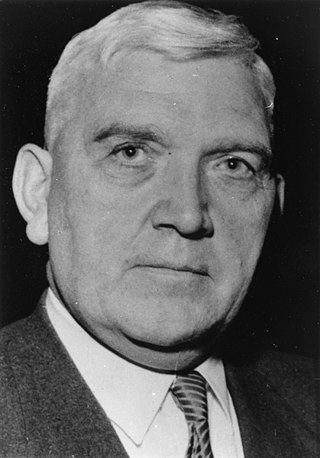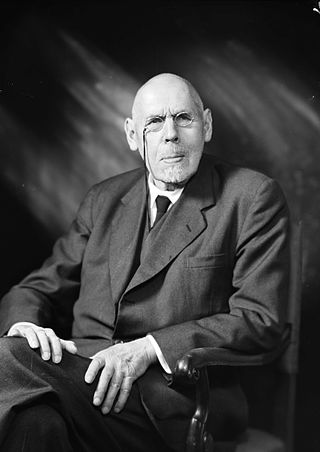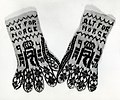
The Norwegian resistance to the occupation of Norway by Nazi Germany began after Operation Weserübung in 1940 and ended in 1945. It took several forms:

The history of Jews in Norway dates back to the 1400s. Although there were very likely Jewish merchants, sailors and others who entered Norway during the Middle Ages, no efforts were made to establish a Jewish community. Through the early modern period, Norway, still devastated by the Black Death, was ruled by Denmark from 1536 to 1814 and then by Sweden until 1905. In 1687, Christian V rescinded all Jewish privileges, specifically banning Jews from Norway, except with a special dispensation. Jews found in the kingdom were jailed and expelled, and this ban persisted until 1851.

A monogram is a motif made by overlapping or combining two or more letters or other graphemes to form one symbol. Monograms are often made by combining the initials of an individual or a company, used as recognizable symbols or logos. A series of uncombined initials is properly referred to as a cypher and is not a monogram.

Gunnar Fridtjof Thurmann Sønsteby DSO was a member of the Norwegian resistance movement during the German occupation of Norway in World War II. Known by the nickname "Kjakan" and as "Agent No. 24", he was the most highly decorated citizen in Norway, including being the only person to have been awarded the War Cross with three swords, Norway's highest military decoration.

Eivind Josef Berggrav was a Norwegian Lutheran bishop. As primate of the Church of Norway, Berggrav became known for his unyielding resistance against the Nazi occupation of Norway during World War II. Berggrav also became an important figure in 20th-century ecumenical movement and served as president of the United Bible Societies.

The German occupation of Norway began on 9 April 1940. In 1942, there were at least 2,173 Jews in Norway. At least 775 of them were arrested, detained and/or deported. More than half of the Norwegians who died in camps in Germany were Jews. 742 Jews were murdered in the camps and 23 Jews died as a result of extrajudicial execution, murder and suicide during the war, bringing the total of Jewish Norwegian dead to at least 765, comprising 230 complete households.
The Osvald Group was a Norwegian organisation that was the most active World War II resistance group in Norway from 1941 to the summer of 1944. Numbering more than 200 members, it committed at least 110 acts of sabotage against Nazi occupying forces and the collaborationist government of Vidkun Quisling. The organisation is perhaps best known for conducting the first act of resistance against the German occupation of Norway, when on 2 February 1942, it detonated a bomb at Oslo East Station in protest against Quisling's inauguration as Minister-President.

Carl Fredriksens Transport was the code name for an operation during the occupation of Norway by Nazi Germany to help Jews and other persecuted Norwegians escape persecution, deportation, and murder in death camps.

Lauritz Sand was a Norwegian topographer, military officer in the Dutch army, estate owner in the Dutch East Indies, business man and resistance pioneer of World War II. He was called the hardest tortured person in Norway during the war, and came to be an important symbol of the resistance against the Nazi regime.
Richard Andvord was a Norwegian businessperson and resistance member.

The Quisling regime, or Quisling government are common names used to refer to the fascist collaboration government led by Vidkun Quisling in German-occupied Norway during the Second World War. The official name of the regime from 1 February 1942 until its dissolution in May 1945 was Den nasjonale regjering. Actual executive power was retained by the Reichskommissariat Norwegen, headed by Josef Terboven.

Sven Arntzen was a Norwegian barrister. He was also the acting director general of the Norwegian Prosecuting Authority from 1945 to 1946, and played an important role in the legal purge in Norway after World War II.

Johan Scharffenberg was a Norwegian psychiatrist, politician, speaker and writer.
Oslogjengen was a sabotage group operating in Oslo from May 1944 to May 1945, during the last year of the occupation of Norway by Nazi Germany. The group had its basis in both the British Special Operations Executive and the Norwegian Milorg, was coordinated by Gunnar Sønsteby, and had around ten members. It was the dominant sabotage group in Oslo between May and September 1944, when they performed a series of successful sabotage operations.
Aake Anker Ording was a Norwegian civil servant and politician for Mot Dag and the Labour Party.
Erling Welle-Strand was a Norwegian writer and resistance member.
Edvard Sylou-Creutz was a Norwegian classical pianist, composer and radio personality, who was especially active in Nazi-controlled radio in Germany and occupied Norway between March 1940 and the autumn of 1942.
Lars Borgersrud is a Norwegian military historian and government scholar. His work has largely centered on World War II in Norway.
Harald Sundt was a Norwegian businessperson.

Oliver Hansen Langeland was a Norwegian military officer and civil servant. He had careers in both civil service and the military, and is best known as leader of Milorg District 13 from 1942 to 1944.

















